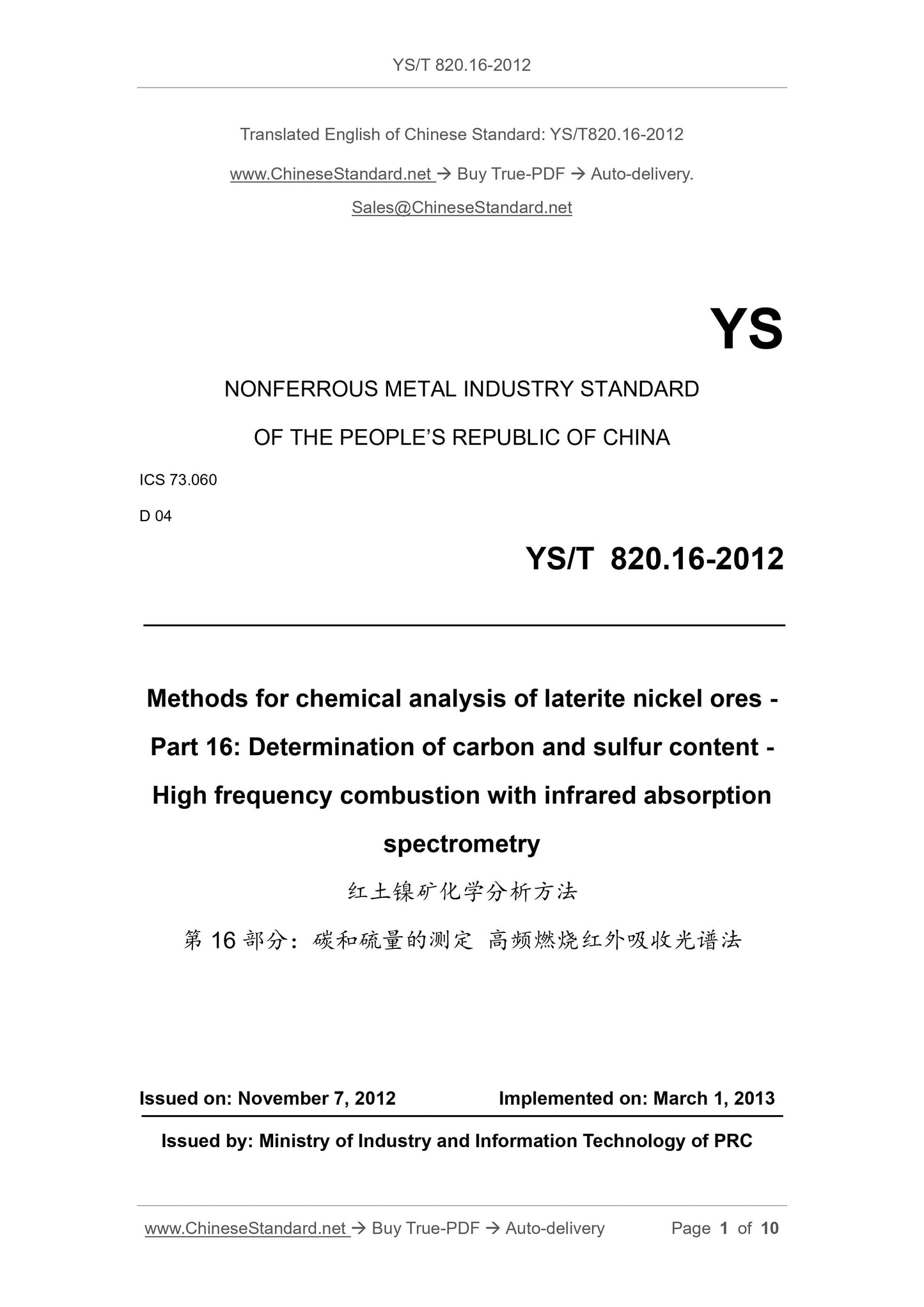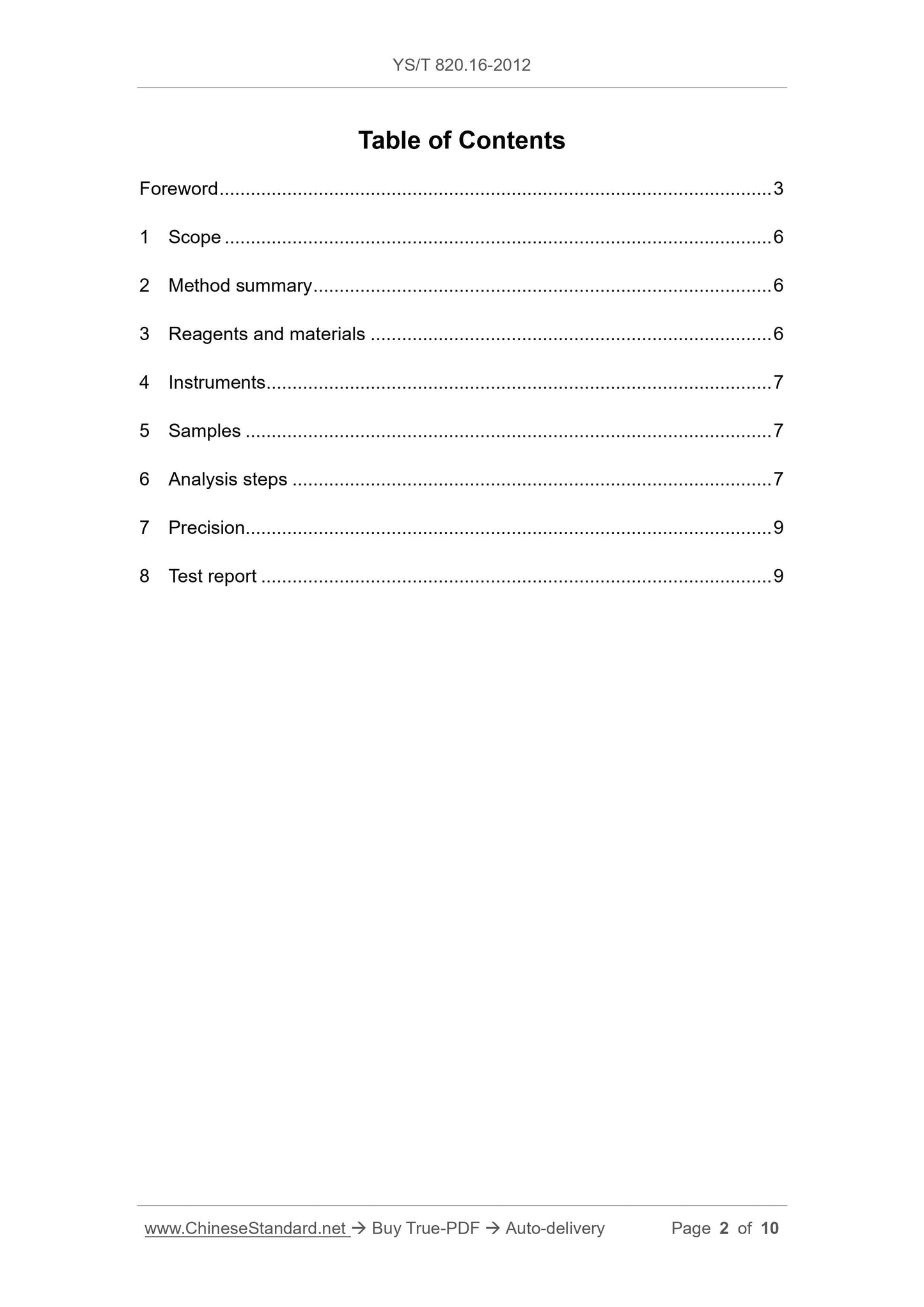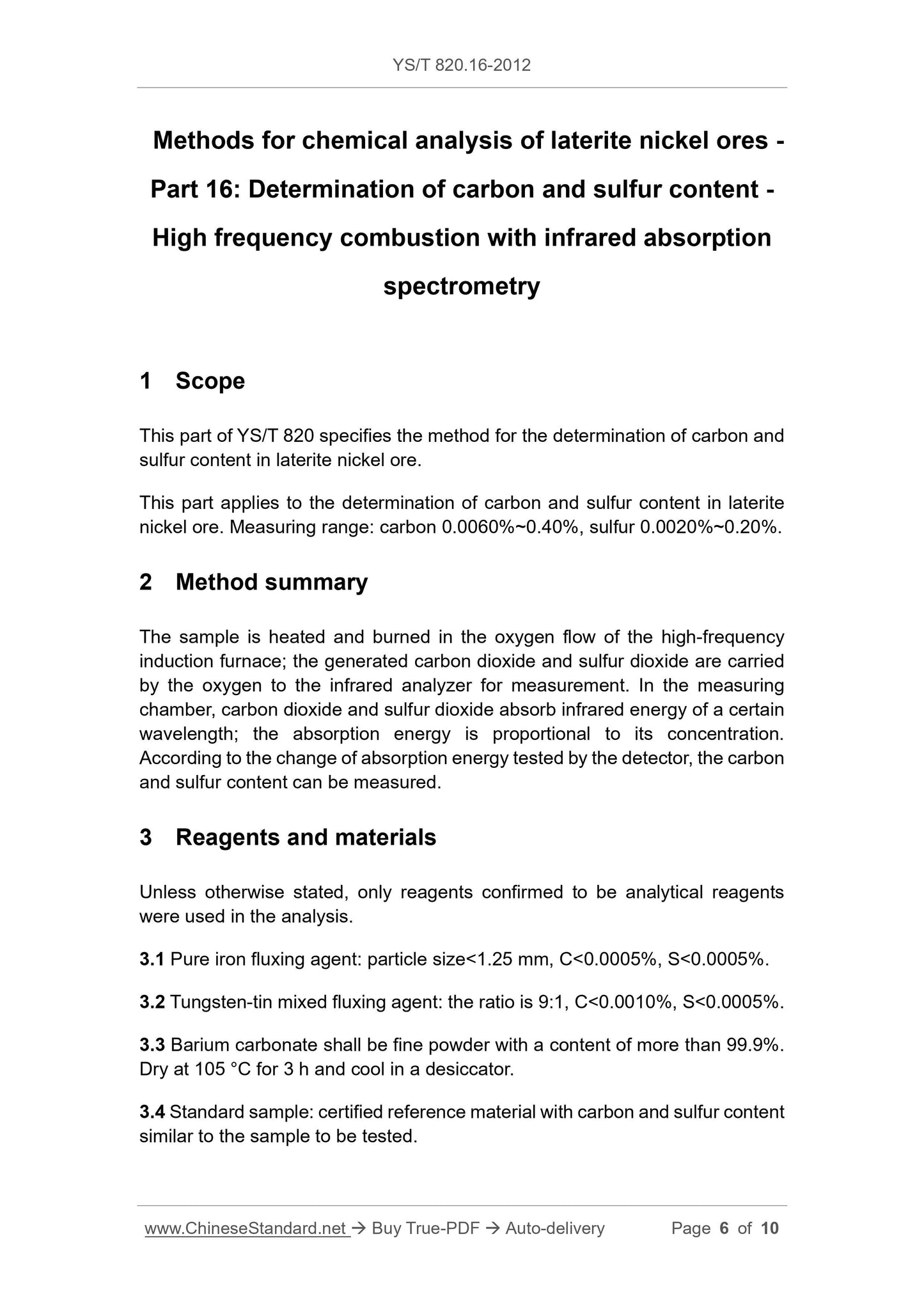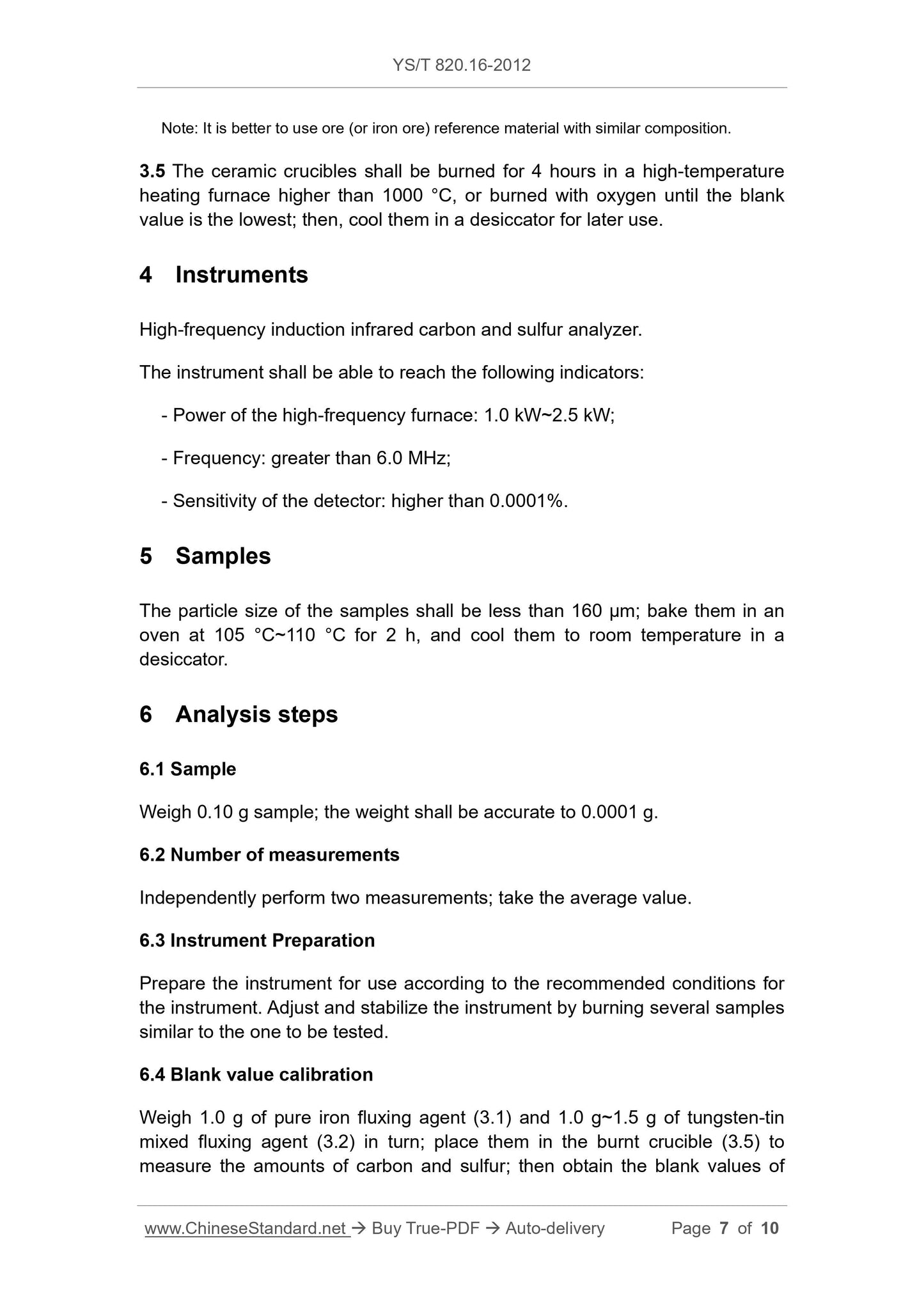1
/
of
4
www.ChineseStandard.us -- Field Test Asia Pte. Ltd.
YS/T 820.16-2012 English PDF (YS/T820.16-2012)
YS/T 820.16-2012 English PDF (YS/T820.16-2012)
Regular price
$130.00
Regular price
Sale price
$130.00
Unit price
/
per
Shipping calculated at checkout.
Couldn't load pickup availability
YS/T 820.16-2012: Methods for chemical analysis of laterite nickel ores - Part 16: Determination of carbon and sulfur content - High frequency combustion with infrared absorption spectrometry
Delivery: 9 seconds. Download (& Email) true-PDF + Invoice.
Get Quotation: Click YS/T 820.16-2012 (Self-service in 1-minute)
Historical versions (Master-website): YS/T 820.16-2012
Preview True-PDF (Reload/Scroll-down if blank)
YS/T 820.16-2012
YS
NONFERROUS METAL INDUSTRY STANDARD
OF THE PEOPLE’S REPUBLIC OF CHINA
ICS 73.060
D 04
Methods for chemical analysis of laterite nickel ores -
Part 16: Determination of carbon and sulfur content -
High frequency combustion with infrared absorption
spectrometry
ISSUED ON: NOVEMBER 7, 2012
IMPLEMENTED ON: MARCH 1, 2013
Issued by: Ministry of Industry and Information Technology of PRC
Table of Contents
Foreword ... 3
1 Scope ... 6
2 Method summary ... 6
3 Reagents and materials ... 6
4 Instruments ... 7
5 Samples ... 7
6 Analysis steps ... 7
7 Precision... 9
8 Test report ... 9
Methods for chemical analysis of laterite nickel ores -
Part 16: Determination of carbon and sulfur content -
High frequency combustion with infrared absorption
spectrometry
1 Scope
This part of YS/T 820 specifies the method for the determination of carbon and
sulfur content in laterite nickel ore.
This part applies to the determination of carbon and sulfur content in laterite
nickel ore. Measuring range: carbon 0.0060%~0.40%, sulfur 0.0020%~0.20%.
2 Method summary
The sample is heated and burned in the oxygen flow of the high-frequency
induction furnace; the generated carbon dioxide and sulfur dioxide are carried
by the oxygen to the infrared analyzer for measurement. In the measuring
chamber, carbon dioxide and sulfur dioxide absorb infrared energy of a certain
wavelength; the absorption energy is proportional to its concentration.
According to the change of absorption energy tested by the detector, the carbon
and sulfur content can be measured.
3 Reagents and materials
Unless otherwise stated, only reagents confirmed to be analytical reagents
were used in the analysis.
3.1 Pure iron fluxing agent: particle size< 1.25 mm, C< 0.0005%, S< 0.0005%.
3.2 Tungsten-tin mixed fluxing agent: the ratio is 9:1, C< 0.0010%, S< 0.0005%.
3.3 Barium carbonate shall be fine powder with a content of more than 99.9%.
Dry at 105 °C for 3 h and cool in a desiccator.
3.4 Standard sample: certified reference material with carbon and sulfur content
similar to the sample to be tested.
Note: It is better to use ore (or iron ore) reference material with similar composition.
3.5 The ceramic crucibles shall be burned for 4 hours in a high-temperature
heating furnace higher than 1000 °C, or burned with oxygen until the blank
value is the lowest; then, cool them in a desiccator for later use.
4 Instruments
High-frequency induction infrared carbon and sulfur analyzer.
The instrument shall be able to reach the following indicators:
- Power of the high-frequency furnace: 1.0 kW~2.5 kW;
- Frequency: greater than 6.0 MHz;
- Sensitivity of the detector: higher than 0.0001%.
5 Samples
The particle size of the samples shall be less than 160 μm; bake them in an
oven at 105 °C~110 °C for 2 h, and cool them to room temperature in a
desiccator.
6 Analysis steps
6.1 Sample
Weigh 0.10 g sample; the weight shall be accurate to 0.0001 g.
6.2 Number of measurements
Independently perform two measurements; take the average value.
6.3 Instrument Preparation
Prepare the instrument for use according to the recommended conditions for
the instrument. Adjust and stabilize the instrument by burning several samples
similar to the one to be tested.
6.4 Blank value calibration
Weigh 1.0 g of pure iron fluxing agent (3.1) and 1.0 g~1.5 g of tungsten-tin
mixed fluxing agent (3.2) in turn; place them in the burnt crucible (3.5) to
measure the amounts of carbon and sulfur; then obtain the blank values of
YS/T 820.16-2012
YS
NONFERROUS METAL INDUSTRY STANDARD
OF THE PEOPLE’S REPUBLIC OF CHINA
ICS 73.060
D 04
Methods for chemical analysis of laterite nickel ores -
Part 16: Determination of carbon and sulfur content -
High frequency combustion with infrared absorption
spectrometry
ISSUED ON: NOVEMBER 7, 2012
IMPLEMENTED ON: MARCH 1, 2013
Issued by: Ministry of Industry and Information Technology of PRC
Table of Contents
Foreword ... 3
1 Scope ... 6
2 Method summary ... 6
3 Reagents and materials ... 6
4 Instruments ... 7
5 Samples ... 7
6 Analysis steps ... 7
7 Precision... 9
8 Test report ... 9
Methods for chemical analysis of laterite nickel ores -
Part 16: Determination of carbon and sulfur content -
High frequency combustion with infrared absorption
spectrometry
1 Scope
This part of YS/T 820 specifies the method for the determination of carbon and
sulfur content in laterite nickel ore.
This part applies to the determination of carbon and sulfur content in laterite
nickel ore. Measuring range: carbon 0.0060%~0.40%, sulfur 0.0020%~0.20%.
2 Method summary
The sample is heated and burned in the oxygen flow of the high-frequency
induction furnace; the generated carbon dioxide and sulfur dioxide are carried
by the oxygen to the infrared analyzer for measurement. In the measuring
chamber, carbon dioxide and sulfur dioxide absorb infrared energy of a certain
wavelength; the absorption energy is proportional to its concentration.
According to the change of absorption energy tested by the detector, the carbon
and sulfur content can be measured.
3 Reagents and materials
Unless otherwise stated, only reagents confirmed to be analytical reagents
were used in the analysis.
3.1 Pure iron fluxing agent: particle size< 1.25 mm, C< 0.0005%, S< 0.0005%.
3.2 Tungsten-tin mixed fluxing agent: the ratio is 9:1, C< 0.0010%, S< 0.0005%.
3.3 Barium carbonate shall be fine powder with a content of more than 99.9%.
Dry at 105 °C for 3 h and cool in a desiccator.
3.4 Standard sample: certified reference material with carbon and sulfur content
similar to the sample to be tested.
Note: It is better to use ore (or iron ore) reference material with similar composition.
3.5 The ceramic crucibles shall be burned for 4 hours in a high-temperature
heating furnace higher than 1000 °C, or burned with oxygen until the blank
value is the lowest; then, cool them in a desiccator for later use.
4 Instruments
High-frequency induction infrared carbon and sulfur analyzer.
The instrument shall be able to reach the following indicators:
- Power of the high-frequency furnace: 1.0 kW~2.5 kW;
- Frequency: greater than 6.0 MHz;
- Sensitivity of the detector: higher than 0.0001%.
5 Samples
The particle size of the samples shall be less than 160 μm; bake them in an
oven at 105 °C~110 °C for 2 h, and cool them to room temperature in a
desiccator.
6 Analysis steps
6.1 Sample
Weigh 0.10 g sample; the weight shall be accurate to 0.0001 g.
6.2 Number of measurements
Independently perform two measurements; take the average value.
6.3 Instrument Preparation
Prepare the instrument for use according to the recommended conditions for
the instrument. Adjust and stabilize the instrument by burning several samples
similar to the one to be tested.
6.4 Blank value calibration
Weigh 1.0 g of pure iron fluxing agent (3.1) and 1.0 g~1.5 g of tungsten-tin
mixed fluxing agent (3.2) in turn; place them in the burnt crucible (3.5) to
measure the amounts of carbon and sulfur; then obtain the blank values of
Delivery: 9 seconds. Download (& Email) true-PDF + Invoice.
Get Quotation: Click YS/T 820.16-2012 (Self-service in 1-minute)
Historical versions (Master-website): YS/T 820.16-2012
Preview True-PDF (Reload/Scroll-down if blank)
YS/T 820.16-2012
YS
NONFERROUS METAL INDUSTRY STANDARD
OF THE PEOPLE’S REPUBLIC OF CHINA
ICS 73.060
D 04
Methods for chemical analysis of laterite nickel ores -
Part 16: Determination of carbon and sulfur content -
High frequency combustion with infrared absorption
spectrometry
ISSUED ON: NOVEMBER 7, 2012
IMPLEMENTED ON: MARCH 1, 2013
Issued by: Ministry of Industry and Information Technology of PRC
Table of Contents
Foreword ... 3
1 Scope ... 6
2 Method summary ... 6
3 Reagents and materials ... 6
4 Instruments ... 7
5 Samples ... 7
6 Analysis steps ... 7
7 Precision... 9
8 Test report ... 9
Methods for chemical analysis of laterite nickel ores -
Part 16: Determination of carbon and sulfur content -
High frequency combustion with infrared absorption
spectrometry
1 Scope
This part of YS/T 820 specifies the method for the determination of carbon and
sulfur content in laterite nickel ore.
This part applies to the determination of carbon and sulfur content in laterite
nickel ore. Measuring range: carbon 0.0060%~0.40%, sulfur 0.0020%~0.20%.
2 Method summary
The sample is heated and burned in the oxygen flow of the high-frequency
induction furnace; the generated carbon dioxide and sulfur dioxide are carried
by the oxygen to the infrared analyzer for measurement. In the measuring
chamber, carbon dioxide and sulfur dioxide absorb infrared energy of a certain
wavelength; the absorption energy is proportional to its concentration.
According to the change of absorption energy tested by the detector, the carbon
and sulfur content can be measured.
3 Reagents and materials
Unless otherwise stated, only reagents confirmed to be analytical reagents
were used in the analysis.
3.1 Pure iron fluxing agent: particle size< 1.25 mm, C< 0.0005%, S< 0.0005%.
3.2 Tungsten-tin mixed fluxing agent: the ratio is 9:1, C< 0.0010%, S< 0.0005%.
3.3 Barium carbonate shall be fine powder with a content of more than 99.9%.
Dry at 105 °C for 3 h and cool in a desiccator.
3.4 Standard sample: certified reference material with carbon and sulfur content
similar to the sample to be tested.
Note: It is better to use ore (or iron ore) reference material with similar composition.
3.5 The ceramic crucibles shall be burned for 4 hours in a high-temperature
heating furnace higher than 1000 °C, or burned with oxygen until the blank
value is the lowest; then, cool them in a desiccator for later use.
4 Instruments
High-frequency induction infrared carbon and sulfur analyzer.
The instrument shall be able to reach the following indicators:
- Power of the high-frequency furnace: 1.0 kW~2.5 kW;
- Frequency: greater than 6.0 MHz;
- Sensitivity of the detector: higher than 0.0001%.
5 Samples
The particle size of the samples shall be less than 160 μm; bake them in an
oven at 105 °C~110 °C for 2 h, and cool them to room temperature in a
desiccator.
6 Analysis steps
6.1 Sample
Weigh 0.10 g sample; the weight shall be accurate to 0.0001 g.
6.2 Number of measurements
Independently perform two measurements; take the average value.
6.3 Instrument Preparation
Prepare the instrument for use according to the recommended conditions for
the instrument. Adjust and stabilize the instrument by burning several samples
similar to the one to be tested.
6.4 Blank value calibration
Weigh 1.0 g of pure iron fluxing agent (3.1) and 1.0 g~1.5 g of tungsten-tin
mixed fluxing agent (3.2) in turn; place them in the burnt crucible (3.5) to
measure the amounts of carbon and sulfur; then obtain the blank values of
YS/T 820.16-2012
YS
NONFERROUS METAL INDUSTRY STANDARD
OF THE PEOPLE’S REPUBLIC OF CHINA
ICS 73.060
D 04
Methods for chemical analysis of laterite nickel ores -
Part 16: Determination of carbon and sulfur content -
High frequency combustion with infrared absorption
spectrometry
ISSUED ON: NOVEMBER 7, 2012
IMPLEMENTED ON: MARCH 1, 2013
Issued by: Ministry of Industry and Information Technology of PRC
Table of Contents
Foreword ... 3
1 Scope ... 6
2 Method summary ... 6
3 Reagents and materials ... 6
4 Instruments ... 7
5 Samples ... 7
6 Analysis steps ... 7
7 Precision... 9
8 Test report ... 9
Methods for chemical analysis of laterite nickel ores -
Part 16: Determination of carbon and sulfur content -
High frequency combustion with infrared absorption
spectrometry
1 Scope
This part of YS/T 820 specifies the method for the determination of carbon and
sulfur content in laterite nickel ore.
This part applies to the determination of carbon and sulfur content in laterite
nickel ore. Measuring range: carbon 0.0060%~0.40%, sulfur 0.0020%~0.20%.
2 Method summary
The sample is heated and burned in the oxygen flow of the high-frequency
induction furnace; the generated carbon dioxide and sulfur dioxide are carried
by the oxygen to the infrared analyzer for measurement. In the measuring
chamber, carbon dioxide and sulfur dioxide absorb infrared energy of a certain
wavelength; the absorption energy is proportional to its concentration.
According to the change of absorption energy tested by the detector, the carbon
and sulfur content can be measured.
3 Reagents and materials
Unless otherwise stated, only reagents confirmed to be analytical reagents
were used in the analysis.
3.1 Pure iron fluxing agent: particle size< 1.25 mm, C< 0.0005%, S< 0.0005%.
3.2 Tungsten-tin mixed fluxing agent: the ratio is 9:1, C< 0.0010%, S< 0.0005%.
3.3 Barium carbonate shall be fine powder with a content of more than 99.9%.
Dry at 105 °C for 3 h and cool in a desiccator.
3.4 Standard sample: certified reference material with carbon and sulfur content
similar to the sample to be tested.
Note: It is better to use ore (or iron ore) reference material with similar composition.
3.5 The ceramic crucibles shall be burned for 4 hours in a high-temperature
heating furnace higher than 1000 °C, or burned with oxygen until the blank
value is the lowest; then, cool them in a desiccator for later use.
4 Instruments
High-frequency induction infrared carbon and sulfur analyzer.
The instrument shall be able to reach the following indicators:
- Power of the high-frequency furnace: 1.0 kW~2.5 kW;
- Frequency: greater than 6.0 MHz;
- Sensitivity of the detector: higher than 0.0001%.
5 Samples
The particle size of the samples shall be less than 160 μm; bake them in an
oven at 105 °C~110 °C for 2 h, and cool them to room temperature in a
desiccator.
6 Analysis steps
6.1 Sample
Weigh 0.10 g sample; the weight shall be accurate to 0.0001 g.
6.2 Number of measurements
Independently perform two measurements; take the average value.
6.3 Instrument Preparation
Prepare the instrument for use according to the recommended conditions for
the instrument. Adjust and stabilize the instrument by burning several samples
similar to the one to be tested.
6.4 Blank value calibration
Weigh 1.0 g of pure iron fluxing agent (3.1) and 1.0 g~1.5 g of tungsten-tin
mixed fluxing agent (3.2) in turn; place them in the burnt crucible (3.5) to
measure the amounts of carbon and sulfur; then obtain the blank values of
Share







